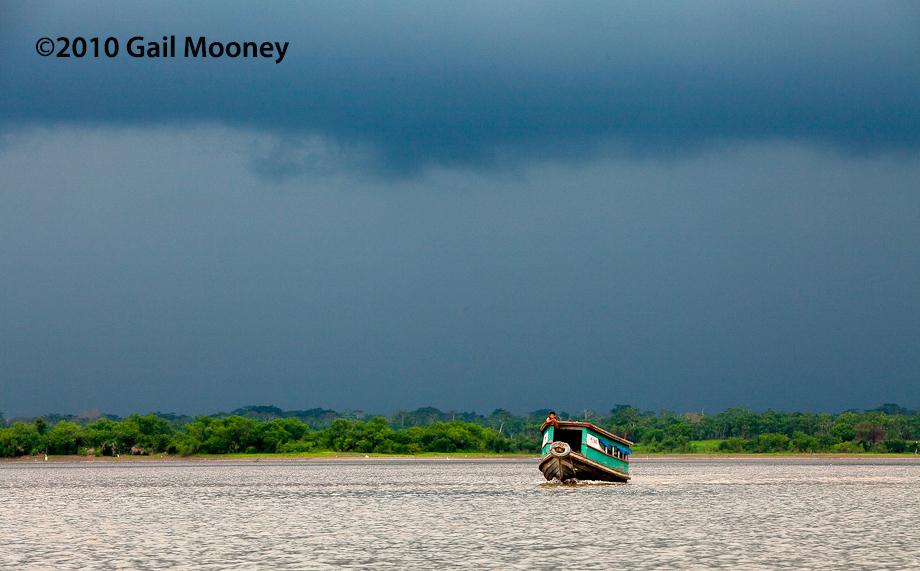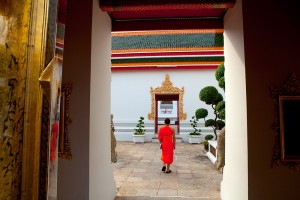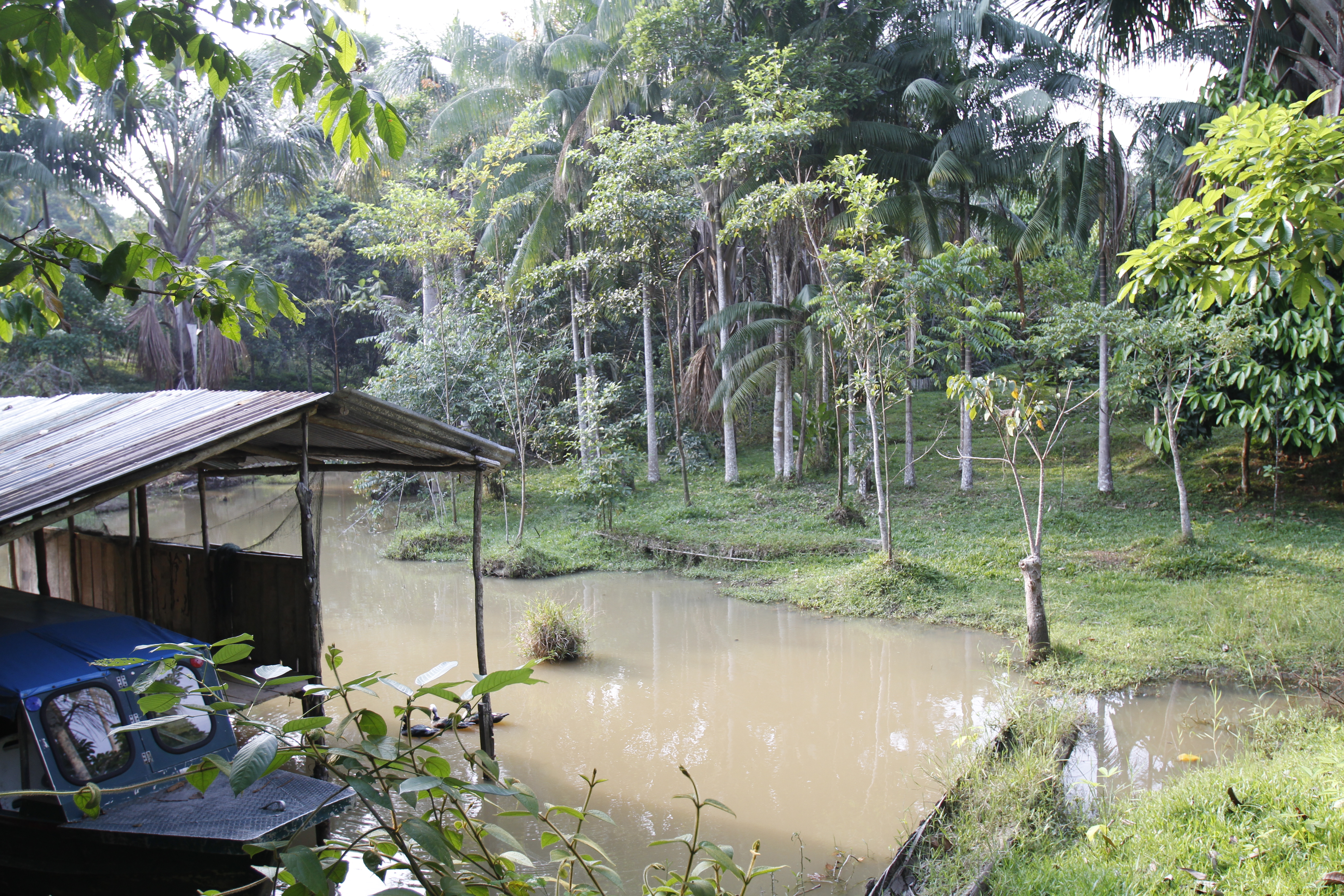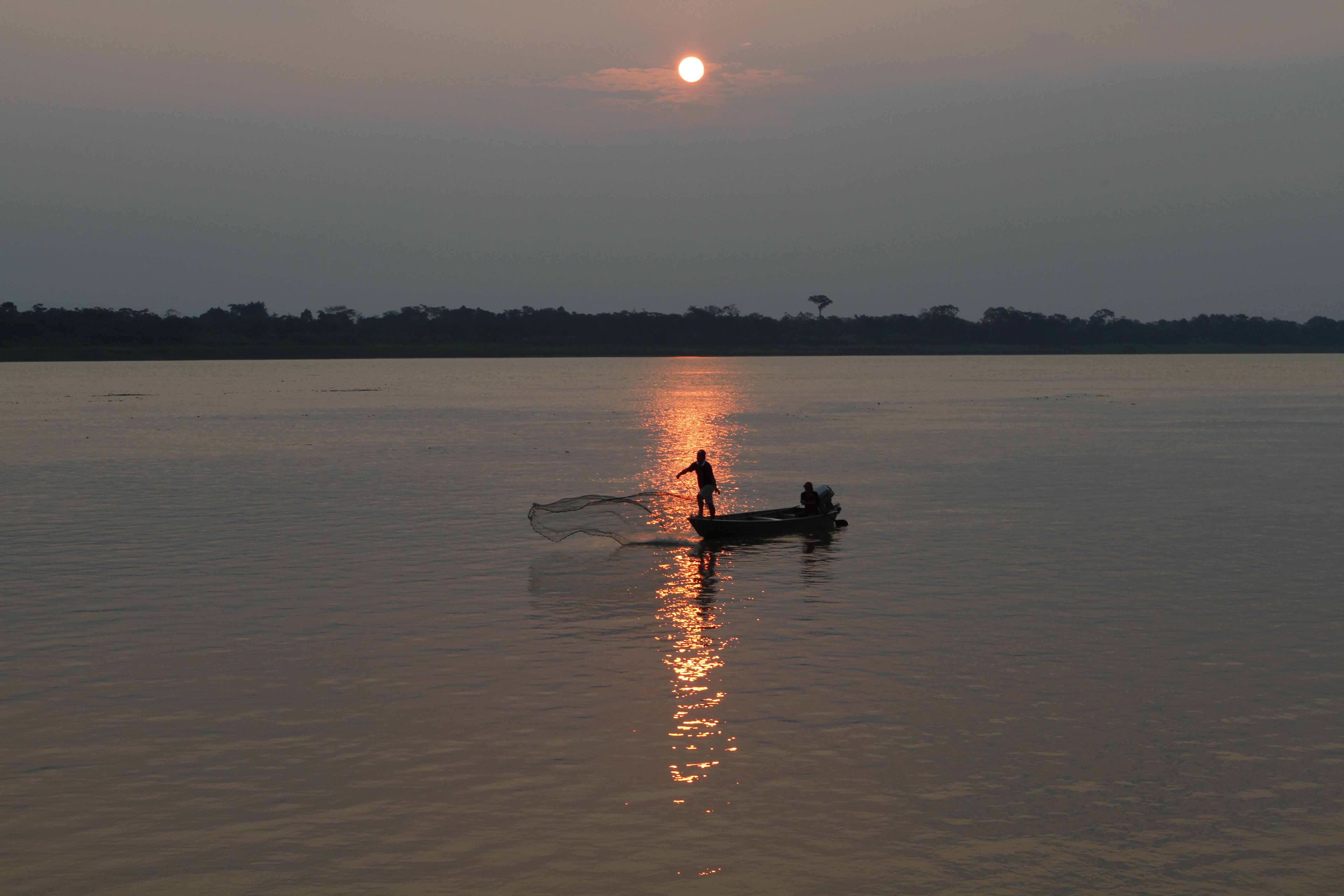Tag Archives: APECA
The day had an ominous look to it, with a dark foreboding sky and choppy water on the great Amazon River. Erin and I were staying at the APECA base camp upriver from the town of Belen, one of the poorest towns along the river. We were planning to go there that day, by boat – everything is done by boat – there are no roads.
and choppy water on the great Amazon River. Erin and I were staying at the APECA base camp upriver from the town of Belen, one of the poorest towns along the river. We were planning to go there that day, by boat – everything is done by boat – there are no roads.
Pablo, Gina Low’s partner at APECA, assessed the situation and decided to go as planned, but he told us it was going to rain and to prepare for it. The trip to Belen took about an hour if my memory serves me well. It was open water with just a few villages along the way and aside from the sound of our motor and those of other boats off in the distance; there was an eerie silence.
When we got to Belen, the skies let loose. Pablo quickly navigated our boat to one of the shacks along the river. We took refuge in this machine shop and watched the storm play out. We were thankful for the cover over our heads and grateful to Pablo for knowing exactly what to do. I think that is what continually impressed me the most about the people in our film, like Pablo. They were all incredibly independent and resilient in difficult situations. They were people you could trust and that says a lot.
The journey is over and the memories have begun to fade. But the legacy lives on in the film my daughter and I created, when we set out some 3 years ago seeking individuals who were making our world a better place. And indeed, we found many people – ordinary people who were doing extraordinary things. And every one of these people had one thing in common – they had found their purpose in helping others.  The more they gave – the more they got back in return. But none of them “gave” with the idea of getting something in return. It wasn’t about getting money, favors, recognition, or other ego related pursuits, it was about caring for their “fellow man”.
The more they gave – the more they got back in return. But none of them “gave” with the idea of getting something in return. It wasn’t about getting money, favors, recognition, or other ego related pursuits, it was about caring for their “fellow man”.
I think that the biggest reward for me in making this film, was sharing that experience with my daughter. She was fortunate to have been born and raised in a beautiful and privileged part of the world and I wanted her to have a greater global perspective. It’s almost impossible to “care” for your “fellow man” when if you don’t have an understanding of who they really are. We all hear about conflict and our “differences” that seem to keep our world divided, but for many of us it’s too distant and outside our consciousness and the confines of our own daily reality.
The truth is the world seems like it’s gotten a whole lot smaller since I was my daughter’s age. It’s amazing how technology has connected us all. What’s even more amazing is the “reach” each one of us has. It’s not very difficult for “one person” to get their message out these days – globally – and instantaneously. Think of the power in that. I realized that first hand with this film and how it has connected people all over the world. I am grateful that I live in an age, when I am able to use my craft, to spread the message about the power each one of us has in making a positive difference in our world – the “power of one”.
But it starts with each one of us, in our own communities and with the people we have relationships with. We can all be a little more thoughtful of how we treat the people we know – that is if we can get outside our own egos. It may be as simple as stopping ourselves before we say something, or do something that could affect someone negatively and ask, “how would I feel if I was on the receiving end?” It’s the little things that we all do and say, that can affect someone, either positively or negatively and that in turn goes on to affect more people and it starts to ripple through “community” and beyond.
I think we all need a reminder from time to time that it serves no purpose to dismiss or treat anyone with disregard, anger or contempt. It only serves to make us bitter inside. I have learned that lesson more than once in my life. The older I get, the more I realize that I’d rather harbor thoughts of love, kindness and forgiveness than hold onto negative ones. Ultimately, life’s too short to focus on the negative.
We each have our own perspective and we each get to choose the lens we see “life” through. I choose a lens of love, respect and caring. I haven’t always chosen that lens and no doubt there will be times in my life, going forward, when I will falter and start seeing life through the wrong lens. Please, let me know when I do.
For those of you who have been asking when Opening Our Eyes will be available – it has been released on DVD and VOD.
 I’ve attended two film festivals to date: The San Luis Obispo Film Festival and the Los Angeles Women’s Film Festival. I can’t begin to describe what it feels like to have a film in a festival, especially so late in my career. As I write “late in my career” there is almost a disconnect. That may be others’ perception of me but for some crazy reason, I don’t feel that way at all. In fact, in many ways I feel like it’s just the beginning.
I’ve attended two film festivals to date: The San Luis Obispo Film Festival and the Los Angeles Women’s Film Festival. I can’t begin to describe what it feels like to have a film in a festival, especially so late in my career. As I write “late in my career” there is almost a disconnect. That may be others’ perception of me but for some crazy reason, I don’t feel that way at all. In fact, in many ways I feel like it’s just the beginning.
“There’s a time for everything” That’s what Dr. David Mar Naw told Erin and I that rainy day we interviewed him in a bamboo hut in a remote hill tribe village in northern Thailand. It seems like a lifetime ago that we met Dr. David, yet it was but a year and a half ago. Had I known that this project would have consumed my time – and me – the way it did – well, let’s say I might not have started it. Yet I did start it, perhaps because I felt that this was the time in my life to do something like this.
Last night the film screened in Los Angeles and it was close to a full house – a few empty seats here and there. There were a lot of friends and colleagues there last night, and even someone I hadn’t seen in 30 years. And to top it off, Gina Low, one of our subjects was in attendance with lots of her family and supporters of Apeca. I hadn’t seen Gina or Pablo since we left Peru in August of 2010. For me, that is the best part about festivals – sharing my film with friends – new and old. That’s why I made this film – to share – not just the film but also the message behind it of what one person can do to make a difference in the world.
After our film screened, there was one last film that night – “Gloria”, a movie about Gloria Steinem. The film was fascinating, a combination of present day and past interviews of Steinem along with lots of historical footage and photos. Even though Gloria has more than a decade of years ahead of me, I vividly remember that period of time in the “women’s movement”. I attended at least two marches that showed up in the film, as a young college aged woman of the time. That era had a profound effect on my life. I had always questioned “fairness” even as a child and when I came of age as a young woman during that time in history, I had little tolerance for people who told me I couldn’t do something because I was a woman. I vividly remember feeling during that period in time, that as a woman, I had been born at just the right time. A time of change.
It’s never easy to be on the forefront of change and yet it seems to be the pattern of my life. So maybe now, during this time of “change”, this is my time to begin yet again another new chapter of my life. I was interviewed last night and was asked two great questions that were easy for me to answer:
The first was “What got you through it” (meaning the journey).
I answered, “The people, behind these stories, they were incredibly inspirational”.
And the other question, “Did making this film change your life?”
My answer “Yes, in every way imaginable – but I knew that it would.”
“Without leaps of imagination, or dreaming, we lose the excitement of possibilities. Dreaming, after all, is a form of planning.” Gloria Steinem
After four days of rest at home, it was rather surreal to get back out on the road again. Four days is a strange amount of time – it’s not enough time for you to completely settle in, but it’s just enough time to throw you off your traveling mode. Nevertheless, it was much needed and it felt routine when we returned to the airport. Just another flight, another immigration control, another taxi ride, another hotel. In fact, it felt so routine that I didn’t even really realize that I was in another country. There was no great sense of wonder or excitement arriving in Lima – perhaps because I had been there before. But it was a different story when we arrived in Iquitos. I was in the Amazon jungle now.
Iquitos is supposedly the world’s largest city that is not connected by road to any other city. You can only get there by plane or by boat. Bustling with “motokars” (auto-rickshaws) and every type of boat you can imagine, it’s hard to believe that this “jungle city” of 200,000 people is as isolated as it is. It was there that we met our subject, Gina Low, who founded APECA Peru – an organization that aims to preserve the Amazon rainforest and its inhabitants through helping the indigenous communities develop sustainable methods of living. We traveled with her to APECA’s base camp, El Fundo, a lush jungle property with an exotic locale, right on the banks of the Amazon river. The trip itself was no simple task – commuter boats along the Amazon only depart when they’re full of people, as gasoline is expensive, so there’s no telling when you’ll leaving or when the boat will come back if you happen to miss it. But there’s nothing like gliding down the Amazon, marveling at its width when what you think is the other bank is actually just an island. It certainly is a memorable experience.
Luckily I got to travel down the Amazon quite a few times, as we visited several villages along the river that APECA has worked with. Gina has been in the region for over 17 years, building relationships with the locals, so it was no surprise that she was received so warmly everywhere we went. She and her partner Pablo Guerra, the director of APECA’s programs, have been bringing much-needed free healthcare to the villages, and carrying out various projects that encourage healthy and sustainable living – constructing clean water systems, building latrines, starting reforestation projects, teaching sustainable fishing and turtle farming, training members of the community to be healthcare educators, etc. It was promising to see some of those projects in place and the individuals that have really run with them – like Teresa, who planted 700 trees that the community can share and use the wood to build their homes with. But it was also difficult to see the conditions that the people live in, and what’s worse, to know that they are complacent with such poverty and will never expect it to ever improve.
In one of the villages, my mom and I were trying to film a community meeting, and many of the children were standing in the way of the camera (wouldn’t you, if you had never seen such a crazy-looking thing before?). To get them to step aside, my mom said “beep beep,” as in a car horn, and instead of moving they started giggling uncontrollably and repeating the sound over and over again, like it was a funny word. I realized that they might not know what we were referring to, so I explained to them that that is what a car horn sounds like. Their faces were blank and I thought oh, they’ve probably never seen a car in their lives, so they have no idea what I’m talking about. So then I said that some boats also make this sound – again, blank faces, and I realized that the only boats they’ve ever seen are dugout canoes and small rowboats with outboard motors. That’s when it really hit me – most of these kids will probably never leave this village in their lives. They will never know what a car is, they will never hear the sound of a horn, and they will never have the opportunities and privileges that most kids in the U.S. squander away without a second thought.
I guess my message here is that despite the plentiful mosquito bites and the lack of running water and electricity, my visit to the Amazon has been an enlightening experience and has shown me, once again, to never take my life and the opportunities I have had for granted.


























